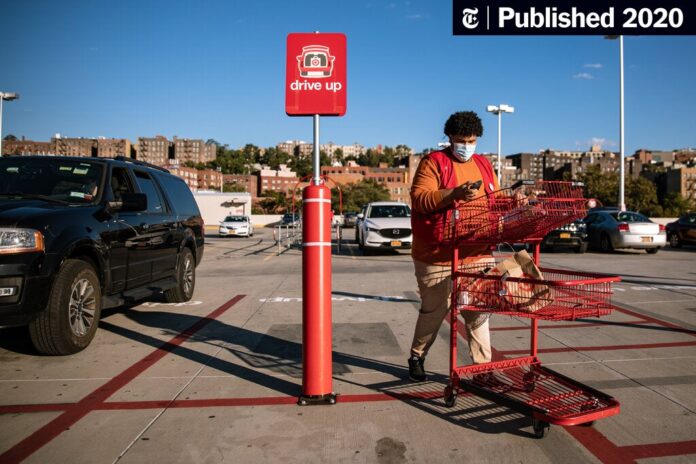Online orders have surged for retailers in the pandemic, as curbside pickup helps Americans satisfy their desire to hop in a car and drive to the store.
Published: October 9,2020
Writers: Sapna Maheshwari and Michael Corkery
Link: https://www.nytimes.com/2020/10/09/business/retailers-curbside-pickup.html
What started as a coronavirus stopgap is likely to have a permanent impact on the way people shop, along with giving them a new reason to continue to visit beleaguered physical stores.
The popularity of curbside pickup reveals that the future of retail is not just more packages piling up on people’s doorsteps. Beyond satisfying the need for contactless shopping in the pandemic, it taps into Americans’ desire to drive to a store, a pull that can be just as strong as, or even stronger than, the convenience of home delivery.
“Americans are used to their cars and actually do like stores, so this is kind of a hybrid where you’re getting the best of both worlds,” said Oliver Chen, a retail analyst at Cowen.
As of August, about three-fourths of the top 50 store-based retailers in the United States offered curbside pickup, according to Coresight Research.
The rise in curbside pickup, part of a larger surge in e-commerce sales, has implications for preserving retail jobs, though workers’ duties are likely to transform.
By driving to the store to pick up an online order, “the customer takes the last mile,” Mr. Chen said, referring to the typically expensive final step in package deliveries.
The 700 percent growth in Target’s Drive Up offering has spurred the chain to add fresh and frozen groceries to the service and create up to 12 additional parking spaces for pickup at stores. It has announced plans to double the number of store employees dedicated to in-store and curbside pickup services during this holiday season.
Walmart, with about 4,700 stores in the United States, was one of the earliest chains to offer curbside pickup, with a focus on groceries. Curbside orders are part of an overall boost in its e-commerce sales. It’s helping the retailer keep pace with Amazon online.
The drive-up service is giving Walmart and other chains another significant advantage — the ability to make a profit on online orders, where the economics are notoriously difficult. Walmart loses money on its traditional e-commerce sales, in which customers order online and the products are shipped to their home.
Walmart now employs 74,000 workers across more than 3,000 stores to pick groceries on orders and then take them out to customers’ cars. Five years ago, there were fewer than 1,000 of those jobs. But during the pandemic, filling those roles was a big driver behind Walmart’s hiring boom, which increased the company’s 1.5 million-person work force by 14 percent.
The job of picking items off the shelf and taking them to a customers’ cars can easily be done by machines. Even now, that work is highly automated. Workers fulfilling curbside orders at Walmart use a hand-held device that indicates the order in which they should pick each item, for maximum efficiency.
Commentary
Since it was published during the Covid-19 pandemic, this article is a good representation of how curbside pick up services were being received right after implementation. Customers enjoyed this idea of curbside pick up because it still kept them safe when getting groceries, but also got them out of the house during the pandemic. The act of driving in the car to the grocery store is an experience that customers seem to enjoy. I’m curious why this is and if the design of the car has anything to do with it. For businesses, curbside pickup is a better alternative to delivery of groceries because of shipping costs. This has allowed large retail stores to compete with large e-commerce delivery stores like Amazon. Curbside pick up provided jobs for people during a time when non-essential workers were being let go. However, the article makes a point to mention that the curbside pickup employees can be replaced by automation in the near future. The problem with this automation could be for disabled people who need human assistance to load their own groceries.




